A couple years ago, I upgraded from an M1 Mac Mini to the M2 Mac Mini and compared it to my M1 Pro MacBook. The M2 was a modest 10-20 percent improvement over the M1, but it was far from the M1 Pro’s multi-core performance. For demanding workloads, it wasn’t a significant upgrade.
What Is the Difference Between M2 and M4?
The M4 Mac Mini offers a 16 GB RAM compared to 8 GB for the M2, a CPU with a faster clock and two additional cores. This results in faster performances across the board, especially for developer tasks like compiling code.
Now, Apple has skipped the M3 entirely and jumped straight to the M4 Mac Mini. On paper, it’s already a more attractive package: the base model finally starts with 16 GB RAM instead of 8 GB (with no price increase), addressing a major criticism, and we are getting a CPU with faster clock, an extra two cores and faster RAM:
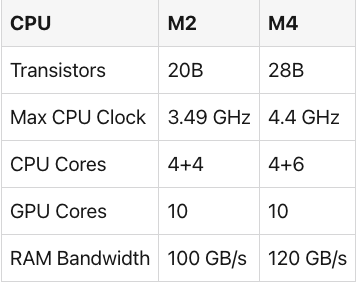
The CPU spec differences may not seem spectacular, but let’s have a look at how they translate into real-world performance gains and whether they might make the M4 a worthy upgrade from an M1 or M2.
M2 vs. M4 Specification Comparisons
Synthetic CPU Benchmarks
I will start with a couple of generic CPU benchmarks, my own DKbench and the popular GeekBench 5. I don’t use version 6 because, in my opinion, it’s broken for multi-core:
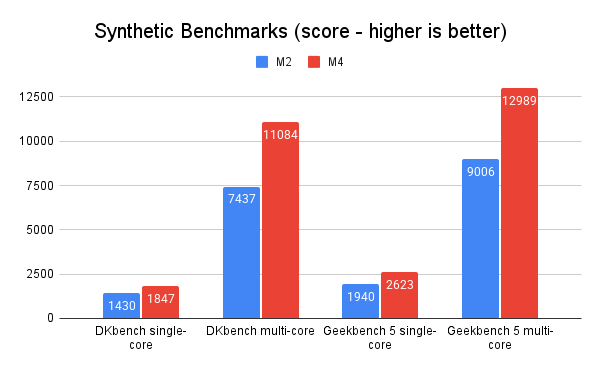
The M4 dominates more than the CPU spec comparison table would indicate; it looks like the M4 core has an improved IPC over the M2. The single core advantage at 30-to-35 percent is quite a bit more than the clock speed increase and the multi-core performance difference touched 50 percent in DKbench. However, under full load on the multi-core DKbench, the M4’s fan gets noticeably, although not annoyingly, loud. But we’ll get into that again later. For now, on to 3D rendering:
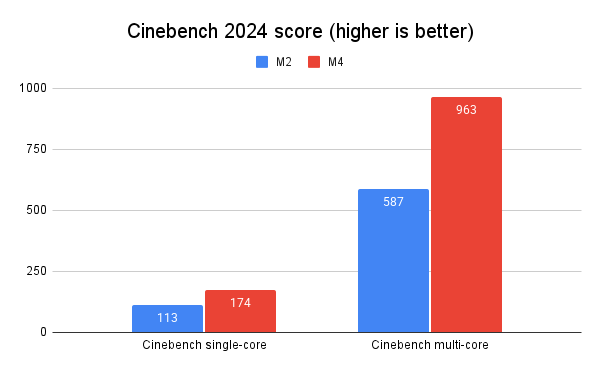
Here, the M4 is over 50 percent faster in single-core and over 60 percent faster in multi-core, an amazing showing. The M4 also supports the GPU Cinebench benchmark, where it scores 3,971. The M2 was not supported by this Cinebench release in order to compare.
Real-World Developer Workloads
On to real-world tasks that concern developers. I timed decompressing the Xcode 16.2 XIP file, running static analysis on Xcode for my my astronomy app and compiling it four times to get a comparable sum:
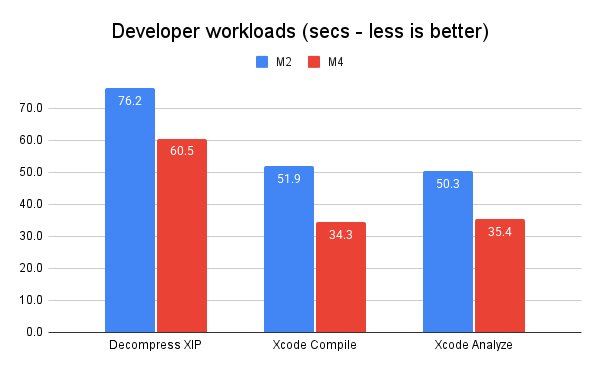
The most useful task, compilation, is the most impressive one, with an over 50 percent performance gain. It should be clear by now, the performance difference is real and would be noticeable in daily work.
Video Compression
As the Mac Mini is ideal for a media center, video transcoding would be a common task. I am trying an FFmpeg H264 transcode, plus a Handbrake SuperHQ HEVC transcode of the same video:
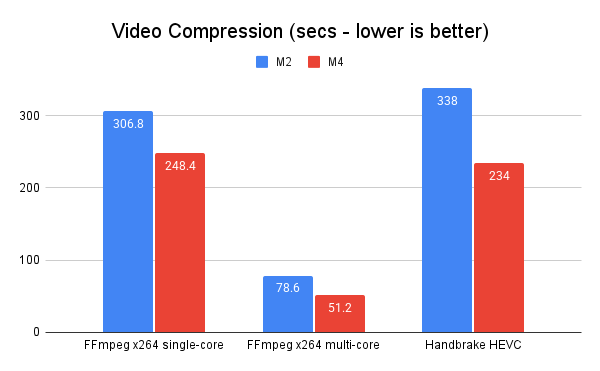
The single-core improvement is not bad at 23 percent, but again the multi-core performance at around 50 percent is very impressive.
CPU Result Table
Here are all the above results collected in table form:
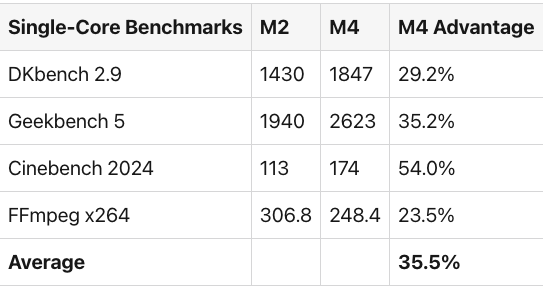
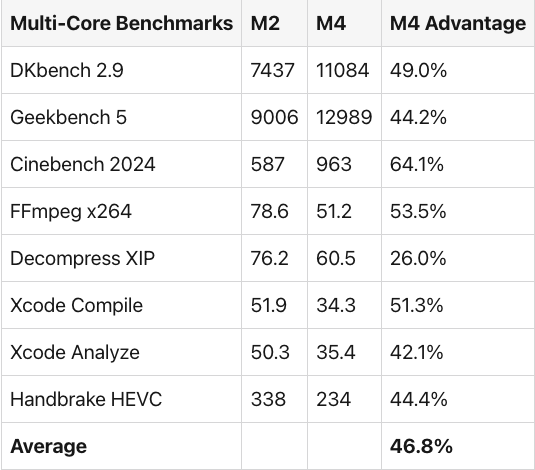
GPU Comparison
I wouldn’t say Macs are gaming machines, due to not having support for the majority of games, and no support for dedicated graphics cards for most models. However, the integrated GPU of the Apple Silicon processors is quite powerful, so I still wanted to see how much improvement there was:
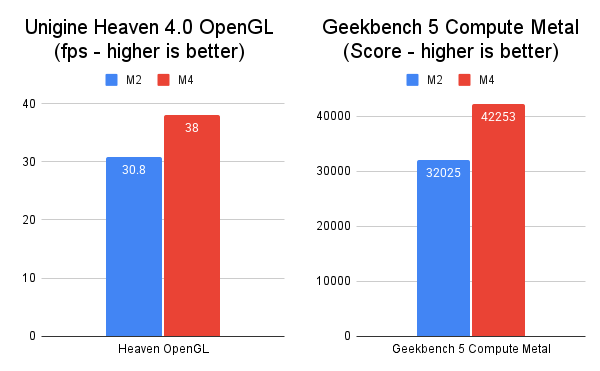
The Unigine Heaven benchmark is quite old, but it does show there was a fair increase in performance (over 20 percent); I had a similar result in Civilization VI, which I did not include above. The gains in the compute benchmark are a bit higher. In any case, you wouldn’t really want to upgrade to the M4 just for the graphics, but it's still good to see an improvement.
SSD Speed
If you recall, going from the M1 to the M2 on the base (256GB) SSD configuration Apple reduced the number of NAND chips from two to one, effectively halving the read speed, a decision that caused quite a stir. Let's see how the M4 base config does:
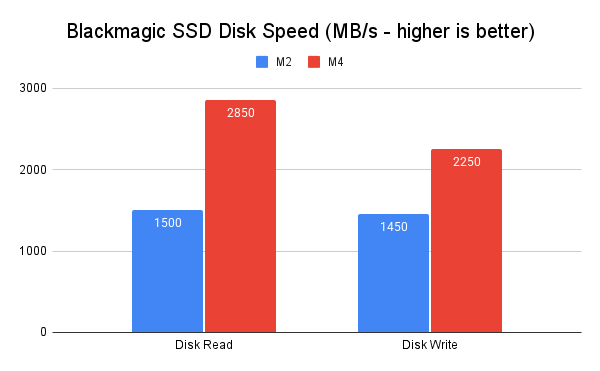
It’s good news, we are back at good levels of performance, finally like M1 or better. Yes, basically matching the original M1 Mac Mini from five years ago is considered good news, and I know that sounds strange. They could’ve at least bumped up the minimum configuration, but I’ll take the RAM increase any day.
Form Factor, Power & Cooling
The old Mac Mini was small, the new one is tiny. A couple of USB-A are sacrificed, but we get five total USB-C/Thunderbolt, up from two. It might be more future-proof, but it does mean you can't get away without hubs/adapters for those USB-A devices you still have. At least they kept ethernet (with a 10Gb option too), 3.5mm audio and HDMI (bumped up to v2.1 from 2.0) ports.

The much smaller size is matched with a hotter, more power consuming CPU:
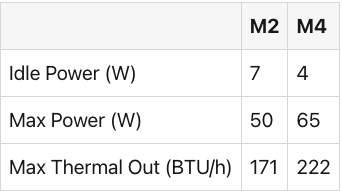
This results in the need for powerful fans to dissipate this heat. As noted above, when running DKbench on 10 cores, I could see my core temperatures quickly reach 100 degrees Celsius, at which point the fan would engage at around 3000 rpm, quickly bringing the temp down to 70-80 degrees Celsius. This took me by surprise as it is quite noticeable. I had never heard any Mac Mini (having both M1 and M2) make any perceivable sound before. At least it is an air/suction sound, not any annoying whirring etc. It is not a huge deal.
If I ran DKbench at six threads, it would not engage the fans and still be over 10 percent faster than the M2. But I have no idea why they chose to go this way. I’m pretty sure no sane Mac Mini user would say “Oh, it’s too big — make it smaller, even if it’s louder.”
M2 vs. M4: Is the M4 Worth It?
It’s clear that the M4 Mac Mini is a substantial upgrade over the M2. The newer CPU alone offers significant performance improvements across the board, especially for heavy tasks — a developer or content creator will actually notice differences in performing daily tasks like compiling, rendering, etc. Moreover, if we are looking specifically at the low cost base config models, twice the RAM and faster SSD with the M4 is a further advantage.
However, I can't help but notice a worrying trend. When the M1 launched, it was a game-changer, offering twice the performance of x86 chips at a fraction of the power consumption, with near-silent cooling. Since then, Apple has kept pushing performance higher, but at the cost of increasing power draw. The Mac Mini’s power ceiling has jumped from 39W (M1) to 50W (M2) to 65W (M4). At the same time, the chassis has gotten smaller, making cooling more difficult.
This reminds me of the previous decade, when Intel was releasing power-hungry CPUs to boost performance, while Apple made laptops thinner and thinner. The result? The 2019 MacBook Pros that throttled under load and had fans constantly running, especially in warm environments. We're obviously not there yet, but hearing the M4 Mini’s fan spin up under heavy load makes me wonder if Apple is starting down a similar path.
For now, though, the M4 remains an excellent upgrade, but I hope future Apple Silicon devices continue to prioritize the efficiency and silent operation that made the M1 such a game-changer.
Frequently Asked Questions
Is it worth upgrading from M2 to M4?
The M4 Mac Mini is considered a substantial upgrade over the M2. The newer CPU offers significant performance upgrades, and the base M4 model has twice the RAM and a faster SSD over the base M2 model.
What is the difference between the M2 and M4?
The M4 Mac Mini is significantly more powerful than the M2, offering a faster clock, an extra two cores and faster RAM. This results in improvements across the board for CPU speeds, video compression and GPU performance.





